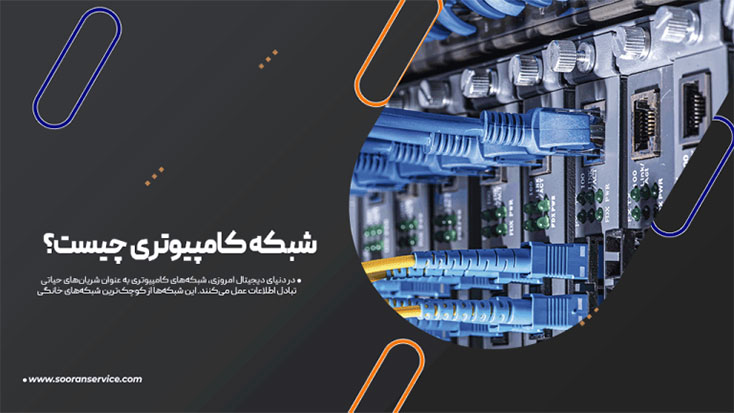In today’s digital world, computer networks act as the lifeblood of information exchange.
From the smallest home networks to the vast global Internet, they play a crucial role in the advancement of technology, the economy, and social communications.
Through computer networks, we can access vast amounts of data, communicate with others, and perform our daily tasks efficiently.
Indeed, computer networks have become an inseparable part of modern life and play a key role in various fields such as business, education, entertainment, and communication.
In this article, we will introduce what a computer network is, how it works, and what its main components are.
Soran Service Novian Company, with the help of experienced engineers in this field, provides professional network infrastructure consulting services tailored to your needs.
What Is a Computer Network?
A computer network is a collection of two or more computers and other devices connected through communication channels that allow them to share data and resources.
These networks can range from small setups, such as a home network with several computers and smartphones, to large-scale systems like the global Internet.
The main purpose of creating computer networks is to increase efficiency, share resources (such as printers, the Internet, and storage space), facilitate communication and collaboration between users, and enhance data security and reliability.
There are different types of computer networks, each with unique features and specific applications, which we will introduce in the following sections.
What Is the Main Purpose of Creating Computer Networks?
One of the main goals of establishing a computer network is resource sharing. Connected devices can use shared resources such as printers, scanners, Internet access, and software applications.
This leads to cost savings and increased efficiency.
Additionally, computer networks make it easier for users to communicate and collaborate. They allow users to work together on projects and share information easily. It is also worth mentioning that with proper computer networks and security systems, data can be centrally stored and managed, ensuring protection and reliability.

Components of a Computer Network
Computer networks are composed of a collection of devices and software that communicate with each other to exchange information. These networks consist of various components, each of which plays an important role in the overall performance of the network.
- Network Interface Card (NIC): This card acts as the interface between the computer and the network, enabling the sending and receiving of data.
- Network Cables: Used for the physical connection between devices. In computer networks, there are different types of cables, such as copper cables and fiber optic cables.
- Hub: A simple device in which all ports are connected together and any received data is sent to all ports.
- Switch: A smarter device than a hub that sends data only to the destination port, reducing network traffic.
- Router: A device that routes data packets between different networks and provides access to the Internet.
- Modem: A device that converts digital signals into analog signals for transmission over telephone lines and vice versa.
- Server: A powerful computer that shares network resources such as files, printers, and various services.
- Client: A device that connects to the server and uses its shared resources.
- Network Operating System (NOS): Software that manages network resources and enables file sharing, printer sharing, and other network functions.
- Network Protocols: A set of rules and standards used for communication between devices in a network. It should be noted that the most important network protocols include TCP/IP.
- Network Application Software: Applications used to perform specific tasks within the network, such as web browsers, email software, and network management tools.
- Network Addresses: Each device in a network has a unique address used for identification.
- Network Topology: Network topology refers to the way devices are connected within a network. Common topologies in computer networks include star, ring, and bus configurations.

How Does a Computer Network Work?
The operation of a computer network is a complex process that involves multiple stages and protocols. The main goal of this process is to ensure the efficient and reliable transfer of data between the devices connected to the network.
This process takes place continuously and automatically.
In fact, computer networks are collections of interconnected devices designed for the exchange of information. These devices are linked together through cables, Wi-Fi, or other communication technologies and are identified by unique addresses.
Data within a computer network is transmitted in the form of small data packets, and routers are responsible for routing these packets to their destinations. Protocols serve as a set of rules that define how data is sent and received across the network.
As a result, computer networks enable us to share information, access shared resources, and communicate with one another effectively.
Conclusion
In conclusion, as mentioned above, computer networks are not only communication tools but also the foundation for personal and social development.
By gaining a better understanding of these technologies and the challenges they face, we can shape a brighter and more prosperous future for ourselves and our communities — because computer networks form the fabric of our digital world.
From the smallest local network to the vast global Internet, these infrastructures act as bridges connecting people, businesses, and societies.
Network infrastructure is one of the most essential parts of any organization, and Soran Service Novian stands by your side in designing and implementing reliable and efficient network systems.
With the rapid advancement of technology, networks continue to evolve, pushing the boundaries of global communication and data exchange.
Therefore, gaining a thorough understanding of how networks work is highly valuable and beneficial.
For more information about computer networks and their implementation, simply contact us and receive expert guidance from our experienced consultants and specialists.




No comments yet.